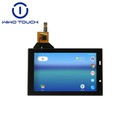The dynamic scanning mode of capacitive touch screens is an intelligent power management technology designed to automatically adjust the scanning frequency according to the use state of the touch screen, thus achieving higher energy efficiency while maintaining touch performance. This model has been used in a wide variety of devices, including consumer electronics, industrial control equipment, smart home and medical devices. This paper will discuss the principle of dynamic scanning mode and its current application.
How dynamic scan mode works
Dynamic scan mode achieves low power operation by controlling the operating frequency of the touch chip, which usually includes the following two main states:
Low-frequency sweep mode
When the touch screen is in standby state or the user does not touch the operation, the system switches to the low-frequency scanning mode, only at a lower scanning frequency to monitor whether there is touch. This mode significantly reduces the power consumption of the touch chip, while ensuring that the device can respond quickly to the user's operations.
High frequency scanning mode
When the system detects a touch signal, it switches to high-frequency scanning mode immediately, providing accurate and smooth touch response. The high frequency scanning in this mode can capture complex commands such as multi-touch and gesture operations.
Through this dynamic adjustment mechanism, the touch screen strikes a balance between performance and power consumption.
Current application of dynamic scan mode
Smartphones and tablets
Smartphones and tablets are the most typical application areas for dynamic scanning mode. When the user does not touch the screen, the touch chip runs a low-frequency scan to extend the standby time of the device. When the user starts the operation, the system quickly switches to the high-frequency scanning mode to ensure a smooth user experience.
Representative case: Many high-end smartphone brands have improved battery life through dynamic scanning technology, especially when the screen is lit up for a long time.
Industrial automation equipment
In industrial touch devices, the dynamic scan mode ensures the stability of the device over a long period of time by reducing energy consumption in the idle state, while maintaining a sensitive response to user operations. This is particularly important in industrial Settings, where these devices often need to operate around the clock.
Smart home device
Smart home devices, such as smart speakers, thermostats, smart door locks, etc., are also widely used in dynamic scanning mode. The touch screen keeps its power consumption low when in standby, and responds quickly when the user approaches or touches it. This capability improves the user experience while reducing power consumption for long-term operation.
Medical equipment
Medical touch devices have high requirements for standby time and real-time response. In medical monitors and portable diagnostic equipment, dynamic scanning mode reduces energy consumption and ensures that the equipment can respond quickly to emergency operations.
Self-service terminals and public devices
Dynamic scanning technology has also been widely used in public touch terminals such as self-service ticket machines and self-service cash registers. It significantly reduces the energy consumption of these devices during off-peak use, while maintaining a ready-to-use state.
Wearable device
Small devices such as smartwatches and fitness trackers especially rely on dynamic scanning modes. Due to battery capacity limitations, these devices maximize battery life by dynamically adjusting the touch scanning frequency.
Advantages and challenges of dynamic scanning mode
advantage
Reduce power consumption: effectively reduce energy waste in idle state.
Extended equipment life: Especially suitable for battery powered equipment.
Improve user experience: Quickly switch to high frequency mode to ensure touch sensitivity.
Challenge
Balance of response time: The time to switch from low-frequency scanning to high-frequency scanning needs to be as short as possible, otherwise it may affect the user experience.
Hardware and algorithm optimization: The implementation of dynamic scanning requires a high degree of collaboration between touch chips and software algorithms, which puts higher requirements on technology research and development.
Future development direction
Ai-assisted dynamic scanning
In the future, artificial intelligence technology will further optimize the dynamic scanning mode. For example, by learning the user's usage habits, the touch control system can predict operational behavior and switch to high-frequency scanning mode in advance, further improving response speed and energy efficiency.
Dynamic adjustment of multiple scenarios
Different application scenarios have different requirements for touch sensitivity and power consumption. Future dynamic scanning technologies will have scene-sensing capabilities and automatically adjust scanning modes according to conditions such as ambient light and user distance.
Hardware performance improvement
With the improvement of the touch chip process, the dynamic scan mode will be switched faster and with lower power consumption, supporting more devices.
Combined with a flexible touch screen
The application of dynamic scanning technology on flexible touch screens will further promote the technological progress of wearable devices and portable devices, providing low power consumption and high sensitivity solutions for new devices.
Conclusion
The dynamic scanning mode of capacitive touch screen has become an important means to reduce power consumption, and has shown excellent application value in many fields. From smartphones to industrial equipment, from smart homes to medical terminals, this technology is driving energy efficiency while meeting user needs. In the future, with the continuous progress of hardware technology and intelligent algorithms, dynamic scanning mode will achieve more efficient and intelligent applications in more devices.




